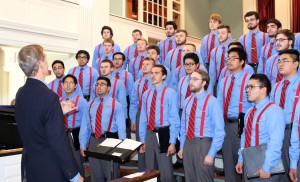
“From the hills of Maine to the Western plain, or where the cotton is blowing;
from the gloomy shade of the northern pine, to the light of the southern seas…”
And so it goes.
It’s a tune that can flow out of the mouths of students and alumni without hesitation. But, interestingly enough, that familiar tune is not the original.
Dr. Richard Bowen, Glee Club Director and Assistant Professor of Music, did some research over the past several weeks and, with the help of the Wabash College Glee Club, shared some of the song’s secrets at his Chapel Talk on Thursday, “Will the Real ‘Old Wabash’ Please Stand Up: Reflections and Revelations Regarding Wabash’s Favorite Song.”
Bowen said that when he announced his Chapel Talk title to the Glee Club, he was not prepared for their reaction, which was, “Wow! We didn’t know you were so hip Dr. Bowen.”
“Really? I’m hip?” he asked.
“Yeah, you lifted your title from Eminem,” they responded.
Bowen shared that he had no idea what they were talking about, and just like that, he wasn’t so hip.
But unlike “Slim Shady,” there aren’t necessarily imitations of our current “Old Wabash.” There is one version written sometime in 1896 that is very different from today’s, which was written around 1900, yet this one was also titled “Old Wabash.”
The 1896 version has no known author, but, Bowen asked, “Is this the real ‘Old Wabash?’”
“Such a claim, however, fails on two accounts,” Bowen explained. “It did not capture enough attention to ensure widespread performance, and it was not designated as the official song.”

That designation went to Carroll Ragan and Edwin Meade Robinson’s version, which is similar to the song that is sung today. But not exactly.
Ragan originally composed the music to be a played as a concert band march for former Wabash President William Patterson Kane’s inauguration in 1900. But then the school offered $50 (which was a lot back then) to whomever could write a new school song. So Ragan gave the music to Robinson, who wrote the lyrics to “Old Wabash.”
Generally, words come first in songwriting. And if they don’t, normally the composer knows the music will be partnered with vocals. Since this was not the case, Robinson had a difficult time finding a proper flow for the lyrics. Despite later admitting parts of the song were rough and awkward, it must’ve impressed Wabash because his words live on.
“Old Wabash” was originally composed in the key of E flat, which gave it a range similar to the “Star-Spangled Banner.” It also had a two-step style to it because of the march it was originally composed to be.
Because of its difficulty, the song’s key was lowered in 1915 and the style was changed to swing. In 1970, a tenor descant was added, while revisions to the piano accompaniment were made in recent years.
“‘Old Wabash’ continues to evolve,” Bowen said. “Does ‘Old Wabash’ sound the same today as it did in 1900? Certainly not. In the future year of 2082, will ‘Old Wabash’ sound exactly the same as it does today? I kind of doubt it.
“Is ‘Old Wabash’ a better song today than it was 116 years ago?” Bowen asked. “My answer is a resounding yes. ‘Old Wabash’ remains today a vibrant, relevant, almost-living organism that continues to occupy a vital place in the larger life of Wabash College. If it had not changed, I wonder if we would still be singing it?”